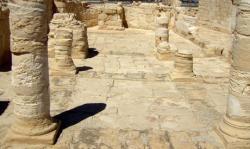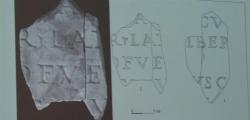INSTITUT SUPERIEUR D'ANTHROPOLOGIE
INSTITUTE OF ANTHROPOLOGY
ONLINE COURSES / COURS A DISTANCE
SPRING SESSION : APRIL 2013
REGISTER NOW
EGYPTE –  Al Bordan - Egypt antiquities police and archeologists stop illegal construction at Al-Bordan archaeological site on Alexandria-Marsa Matrouh highway, yet damages completely destruct site. Al-Hamam Antiquities Inspectorate has succeeded to remove encroachment on Al-Bordan archaeological site, located on Alexandria-Marsa Matrouh highway, in collaboration with Egypt’s tourism and antiquities police. The site includes remains of Graeco-Roman fortresses, roads, temples and cemeteries. The encroachment on the Al-Bordan archaeological site, located on kilometre 67 on Alexandria-Marsa Matrouh highway, started Friday when a large truck invaded the site with a construction bulldozer, which on its turn damaged a cluster of authentic structures that date back to the Graeco-Roman era, according to director of Marina Al-Alamein Antiquities Khaled Abul-Magd. On Saturday, all encroachment has been removed, but the site is almost completely damaged.
Al Bordan - Egypt antiquities police and archeologists stop illegal construction at Al-Bordan archaeological site on Alexandria-Marsa Matrouh highway, yet damages completely destruct site. Al-Hamam Antiquities Inspectorate has succeeded to remove encroachment on Al-Bordan archaeological site, located on Alexandria-Marsa Matrouh highway, in collaboration with Egypt’s tourism and antiquities police. The site includes remains of Graeco-Roman fortresses, roads, temples and cemeteries. The encroachment on the Al-Bordan archaeological site, located on kilometre 67 on Alexandria-Marsa Matrouh highway, started Friday when a large truck invaded the site with a construction bulldozer, which on its turn damaged a cluster of authentic structures that date back to the Graeco-Roman era, according to director of Marina Al-Alamein Antiquities Khaled Abul-Magd. On Saturday, all encroachment has been removed, but the site is almost completely damaged.
http://english.ahram.org.eg/NewsContent/9/40/67531/Heritage/Ancient-Egypt/Encroachment-continues-on-Egypts-archaeological-si.aspx
FRANCE –  Autun-La Genetoye - Les premiers résultats du programme collectif de recherches Autun-La Genetoye ont été dévoilés vendredi matin à l’Eduen. 2012 a permis de collecter des plans anciens, des clichés aériens, de cartographier des vestiges déjà repérés et d’engager de nouvelles prospections non invasives de part et d’autre du temple de Janus. Cette zone de confluence entre l’Arroux et le Ternin est connue pour ses vestiges spectaculaires en élévation avec le temple de Janus, mais aussi le théâtre qui a été découvert par photo aérienne en 1976. Il s’agit aussi de comprendre la dynamique et les formes d’occupation humaine de ce secteur qui semble occupé de la Préhistoire au Moyen Âge. Aussi, le cœur de la problématique va concerner le complexe cultuel : son émergence, son évolution, son organisation, ses relations avec la ville antique…Cinquante hectares de parcelles ont été prospectés par la géophysique avec différentes méthodes. La méthode magnétique, électrique, électromagnétique et la prospection radar. Le projet se poursuit sur une première triannuelle entre 2013 et 2015, grâce notamment à la mise en place de trois chantiers de fouilles répartis sur plusieurs secteurs du complexe cultuel antique : les abords immédiats du temps dit de Janus, le théâtre et l’extension du complexe cultuel. Les anomalies détectées en 2012 : Quartier antique théâtre et alentours : mise en évidence de structures et bâtiments au nord du théâtre et présence de trois enclos funéraires. - Janus et alentours : présence d’un bâtiment à l’est et au sud du temple. On note également des éléments de voirie et un grand bâtiment caractérisé par la présence d’un hémicycle. - Secteur dénommé complexe artisanal : présence de structures de chauffe. Cette interprétation liée au feu peut être renforcée par la découverte récente d’une production céramique localisée à proximité du temple de Janus. Redécouverte d’une inscription antique trouvée dans le quartier Marchaux au XIX e siècle. Un véritable puzzle contenant pas moins de 1 250 fragments. Le souvenir de l’inscription s’efface après 1897 et la publication du Corpus inscriptionum latinarum (CIL). L’objectif est donc de recontextualiser le document. Il faut d’abord s’intéresser à la matérialité de l’inscription avant de comprendre le texte. En revanche, l’étude se heurte à plusieurs problèmes, notamment l’absence d’archives, le nombre de fragments, de toute taille, parfois très abîmés…
Autun-La Genetoye - Les premiers résultats du programme collectif de recherches Autun-La Genetoye ont été dévoilés vendredi matin à l’Eduen. 2012 a permis de collecter des plans anciens, des clichés aériens, de cartographier des vestiges déjà repérés et d’engager de nouvelles prospections non invasives de part et d’autre du temple de Janus. Cette zone de confluence entre l’Arroux et le Ternin est connue pour ses vestiges spectaculaires en élévation avec le temple de Janus, mais aussi le théâtre qui a été découvert par photo aérienne en 1976. Il s’agit aussi de comprendre la dynamique et les formes d’occupation humaine de ce secteur qui semble occupé de la Préhistoire au Moyen Âge. Aussi, le cœur de la problématique va concerner le complexe cultuel : son émergence, son évolution, son organisation, ses relations avec la ville antique…Cinquante hectares de parcelles ont été prospectés par la géophysique avec différentes méthodes. La méthode magnétique, électrique, électromagnétique et la prospection radar. Le projet se poursuit sur une première triannuelle entre 2013 et 2015, grâce notamment à la mise en place de trois chantiers de fouilles répartis sur plusieurs secteurs du complexe cultuel antique : les abords immédiats du temps dit de Janus, le théâtre et l’extension du complexe cultuel. Les anomalies détectées en 2012 : Quartier antique théâtre et alentours : mise en évidence de structures et bâtiments au nord du théâtre et présence de trois enclos funéraires. - Janus et alentours : présence d’un bâtiment à l’est et au sud du temple. On note également des éléments de voirie et un grand bâtiment caractérisé par la présence d’un hémicycle. - Secteur dénommé complexe artisanal : présence de structures de chauffe. Cette interprétation liée au feu peut être renforcée par la découverte récente d’une production céramique localisée à proximité du temple de Janus. Redécouverte d’une inscription antique trouvée dans le quartier Marchaux au XIX e siècle. Un véritable puzzle contenant pas moins de 1 250 fragments. Le souvenir de l’inscription s’efface après 1897 et la publication du Corpus inscriptionum latinarum (CIL). L’objectif est donc de recontextualiser le document. Il faut d’abord s’intéresser à la matérialité de l’inscription avant de comprendre le texte. En revanche, l’étude se heurte à plusieurs problèmes, notamment l’absence d’archives, le nombre de fragments, de toute taille, parfois très abîmés…
http://www.lejsl.com/edition-d-autun/2013/03/24/cet-ete-on-fouille
USA – Los Osos - For the first time, work on the Los Osos sewer project has uncovered a Chumash burial site. Los Osos has many archaeological sites so the discovery was not unexpected. The Los Osos Community Services District encountered human remains during preparation work for that agency’s failed attempt to install a sewer in 2005. However, this is the first time remains have been discovered during the county’s project. The sewer project was designed to avoid as many known burial sites as possible. However, this site could not be avoided because it is in the middle of a roadway, Hutchinson said. Small pits were dug to determine the exact boundaries of the archaeological area. The trench through that area was dug using shovels rather than the usual heavy earth-moving equipment. The remains were unearthed when workers were 90 percent through the archaeological area.
http://www.sanluisobispo.com/2013/03/23/2441831/chumash-burial-site-uncovered.html#storylink=rss
THAILANDE – Khao Toh Ngai - A new archaeological site has been discovered in the Andaman coastal Trang province in the Thai South. A group of archaeologists are surveying the new archaeological site at the Khao Toh Ngai and its vicinity, after a number of ancient human skeletons and potteries were recently found there. Panuwat Auesaman confirmed that his team has found numerous human skeletons and potteries and initially assumed that the site was used to perform religious rites or used to be a morgue in which food and necessities contained in the potteries were offered to the dead. Panuwat acknowledged the skeletons clearly portray well-composed human remains and his team has first classified the potteries into three periods, including those of China’s Yuan Dynasty some 700 years ago. , those of Thailand’s ancient Sukhothai era some 700-800 years ago and those of China’s Ming Dynasty in the 20-22 centuries.
http://www.bernama.com/bernama/v7/wn/newsworld.php?id=936516